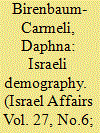|
|
|
Sort Order |
|
|
|
Items / Page
|
|
|
|
|
|
|
| Srl | Item |
| 1 |
ID:
150883


|
|
|
|
|
| Summary/Abstract |
Cities play a vital role in the global climate change mitigation agenda. City population density is one of the key factors that influence urban energy consumption and the subsequent GHG emissions. However, previous research on the relationship between population density and GHG emissions led to contradictory results due to urban/rural definition conundrum and the varying methodologies for estimating GHG emissions. This work addresses these ambiguities by employing the City Clustering Algorithm (CCA) and utilizing the gridded CO2 emissions data. Our results, derived from the analysis of all inhabited areas in the US, show a sub-linear relationship between population density and the total emissions (i.e. the sum of on-road and building emissions) on a per capita basis. Accordingly, we find that doubling the population density would entail a reduction in the total CO2 emissions in buildings and on-road sectors typically by at least 42%. Moreover, we find that population density exerts a higher influence on on-road emissions than buildings emissions. From an energy consumption point of view, our results suggest that on-going urban sprawl will lead to an increase in on-road energy consumption in cities and therefore stresses the importance of developing adequate local policy measures to limit urban sprawl.
|
|
|
|
|
|
|
|
|
|
|
|
|
|
|
|
| 2 |
ID:
182892


|
|
|
|
|
| Summary/Abstract |
With a fertility rate twice higher than the OECD average, Israel is a world outlier in terms of fertility. This article puts together a composite portrait of this exceptional reproductive landscape. Within a comparative framework, it offers context-specific illustrations showing that considered vis-à-vis women in the Former Soviet Union (FSU) and Jewish FSU immigrants to the U.S., FSU immigrants to Israel had higher fertility. Inside Israel, all non-Jewish women have decreased their fertility rate in the past two decades, whereas Jewish women of all strata, but ultra orthodox women, have increased their fertility rate. Given the material challenges of child-rearing in Israel, the article concludes with some questions and preliminary answers regarding Israel’s exceptional fertility rates.
|
|
|
|
|
|
|
|
|
|
|
|
|
|
|
|
| 3 |
ID:
098207


|
|
|
|
|
| Publication |
2010.
|
| Summary/Abstract |
We evaluate the joint use of satellite-observed intensity of urban nightlights and census-based population density data as constraints on the spatial structure of CO2 emissions from fossil fuels. Findings are: (1) the probability that population density exceeds a given value follows a power-law distribution over two orders of magnitude of population density, encompassing the 40% of the global population at the highest densities. (2) The corresponding probability distribution for nightlights intensity also follows a power-law, departing near instrumental saturation. (3) Assuming that the true nightlights intensity distribution follows the power-law above instrumental saturation, we obtain a correction for saturation errors in the nightlights data. The amplification of nightlights intensity required to correct for saturation errors is estimated to be a factor of 1.15-1.23 globally and much greater in regions with high nightlights intensities. (4) Correcting for saturation, we observe clear empirical relationships between nightlights intensity and areal densities of energy consumption, fossil-fuel emissions and economic activity, holding throughout the development spectrum. (5) We indicate how these relationships underpin a fossil-fuel data assimilation system (FFDAS) for estimating fossil-fuel CO2 emissions.
|
|
|
|
|
|
|
|
|
|
|
|
|
|
|
|
| 4 |
ID:
098535


|
|
|
|
|
| Publication |
2010.
|
| Summary/Abstract |
We evaluate the joint use of satellite-observed intensity of urban nightlights and census-based population density data as constraints on the spatial structure of CO2 emissions from fossil fuels. Findings are: (1) the probability that population density exceeds a given value follows a power-law distribution over two orders of magnitude of population density, encompassing the 40% of the global population at the highest densities. (2) The corresponding probability distribution for nightlights intensity also follows a power-law, departing near instrumental saturation. (3) Assuming that the true nightlights intensity distribution follows the power-law above instrumental saturation, we obtain a correction for saturation errors in the nightlights data. The amplification of nightlights intensity required to correct for saturation errors is estimated to be a factor of 1.15-1.23 globally and much greater in regions with high nightlights intensities. (4) Correcting for saturation, we observe clear empirical relationships between nightlights intensity and areal densities of energy consumption, fossil-fuel emissions and economic activity, holding throughout the development spectrum. (5) We indicate how these relationships underpin a fossil-fuel data assimilation system (FFDAS) for estimating fossil-fuel CO2 emissions.
|
|
|
|
|
|
|
|
|
|
|
|
|
|
|
|
|
|
|
|
|